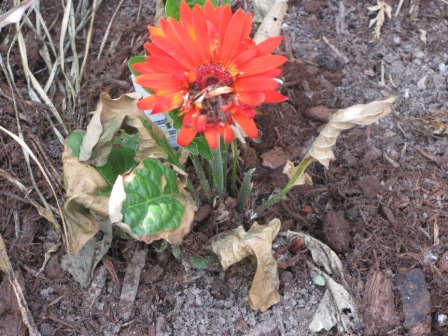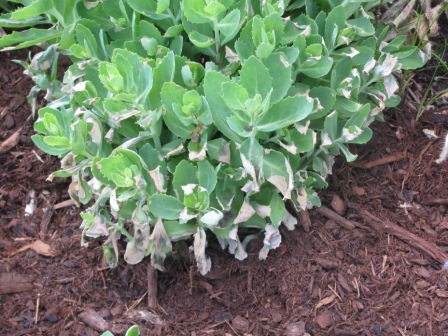We typically think of mulching landscape beds as a good thing. And it usually is; helping to conserve soil moisture, reducing soil temperatures and contributing to soil organic matter. Recently, however, I received an e-mail from a local landscaper that reported severe damage to annuals and perennials in a landscape bed immediately after applying hardwood mulch. The problem, sometimes referred to as ‘sour mulch’ or ‘toxic mulch’, occurs when mulch is left is large piles and undergoes anaerobic conditions. This results in the production of acids and other compounds that can volatilize when the mulch is placed in beds, especially during hot weather. These vapors can quickly damage annuals and other sensitive plants. Mulch in this condition is often characterized by a ‘sour’ smell. If you suspect your mulch has gone sour, spread it out before use to allow toxins to dissipate and water thoroughly either before or immediately after application. The University of Arkansas Extension has a nice fact sheet in the subject “Plant injury from ‘sour’ wood mulch.http://www.uaex.edu/Other_Areas/publications/PDF/FSA-6138.pdf

Fried Gerber daisy

Sedums are usually pretty tough…
And, yes, I did steal the title of this post from one of my all-time favorite ‘Far Sides’…

I had some sour mulch on a project where we planted a couple of long Taxus hedges. The mulch went on, and within a couple of hours the shrubs were turning a faded green; at least half of them had to be replaced within the week, having been burned by the mulch. My understanding is that you want to spread the mulch out (on a tarp or a paved area — not on grass or soil) to air out for 24 hours and to dissipate the acids. Watching plants die from those acids taught me an expensive lesson…
This is one reason I like arborist wood chips so much. Eleven years of using these on my own landscape and dozens of other sites and we’ve never had this problem. Coarse chips stay better aerated and you don’t have the anaerobic respiration products (acids) that you get with big piles of compost, shredded bark, and other less well-aerated materials.
Is this noticed in the hotter regions of the country or to all mulch regardless of location when the weather gets above 85-90 degrees?
I usually don’t spread mulch in the summer anyhow but this is good to know.
Hi,
We recently had an application of sour mulch ruin a lot of plants. Our landscaper claims that pine mulch cannot go “sour” and therefore this can’t be the problem. The mulch is the only common denominator. Can pine mulch go sour?
Thanks,
Hannah
Any material can go “sour” if it’s allowed to become anaerobic. You would know because you would smell it. If mulch has been stored in extremely large piles, the material near the center could easily become anaerobic.
Linda beat me to the punch, but I agree. Most of the articles on-line related to sour mulch tend to discuss hardwood bark but there’s no reason to think it can’t occur in pine or other softwood bark as well. If you’re dealing with large number of plants, it sounds like this could get contentious. Probably a good idea if you can document things with photos – maybe there were some plants that weren’t mulched that are OK. Often times the damage is caused by vapors from acids that can leach quickly from the mulch, so trying to establish cause and effect after the fact can be difficult.
Fumes from the mulch permeate inside my house. It smells like vehicle exhaust fumes. Should I be concerned about this or just bear with it until it goes away?
Dear Betty:
Mulch usually has more of a pungent, sour smell.If you have gas heat, I would be concerned with a gas or exhaust leak. I would consult with your local utility for a safety inspection.